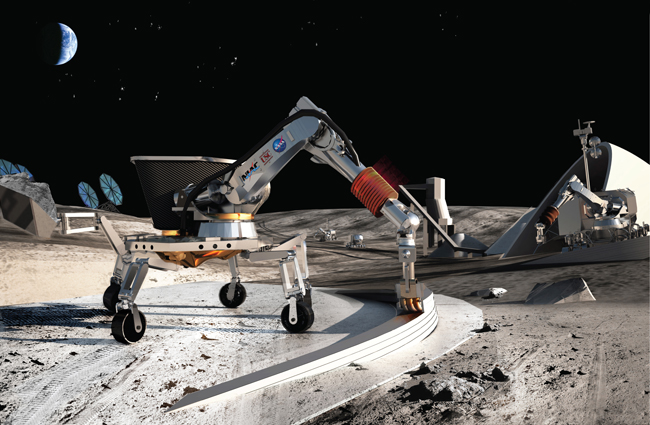
Far-flung building sites usually present design challenges, but for their latest project, Los Angeles-based architects Anders Carlson and Neil Leach are working with conditions that include solar wind, radiation, and a literal lack of atmosphere. Along with fellow USC professors Behrokh Khoshnevis (Engineering) and Madhu Thangavelu (Astronautics), the duo recently won a highly competitive NASA research award to develop robotic construction technologies for inhospitable extraterrestrial environments, such as the Moon and Mars.
 |
| Visualization by Behnaz Farahi and Connor Wingfield A proposed landing pad design. |
The team is researching the use of robots equipped with digital fabrication capabilities to build landing pads, roads, blast walls, and even shelters. Beginning with a 3D-printing technology developed by Khoshnevis that uses waterless concrete made from whatever materials are available in different conditions here on Earth, the foursome is investigating if the same process can be adapted to lunar or Martian environments.
The award is a Phase II NASA Innovative Advanced Concepts [NIAC] research award for a project entitled, ISRU Based Robotic Construction Technologies for Lunar and Martian Infrastructure. It builds on the group’s previous, Phase I, research into using rocks and other resources available on the Moon and Mars as building materials. “We don’t have to send heavy materials from earth to the moon at exorbitant costs,” says Carlson. “It’s a gamechanger if we can reduce cost and develop infrastructure for future, larger missions.”
The Phase I award, ending next month, was a one-year, $100,000 award akin to a Schematic Design phase. Phase II is a two-year award for $500,000. By 2014, the team hopes to prove to NASA that it can build infrastructure capable of performing in extreme environments.
While Khoshnevis and Thangavelu have the science and engineering background needed, they felt bringing in architectural expertise was critical to the research. “We need to think about more than functionality,” says Carlson. “We also need to think about form.”
Carlson and Leach believe their research can also have more practical applications closer to home, such as the use of robotics to rebuild after a nuclear meltdown, natural disaster or environments altered by global warming. “A lot of great things have come out of the space program,” says Carlson. “This research can influence how things get built in the future. It’s really exciting to do something that’s never been done before and figure out the best path to get there.”

Post a comment to this article
Report Abusive Comment